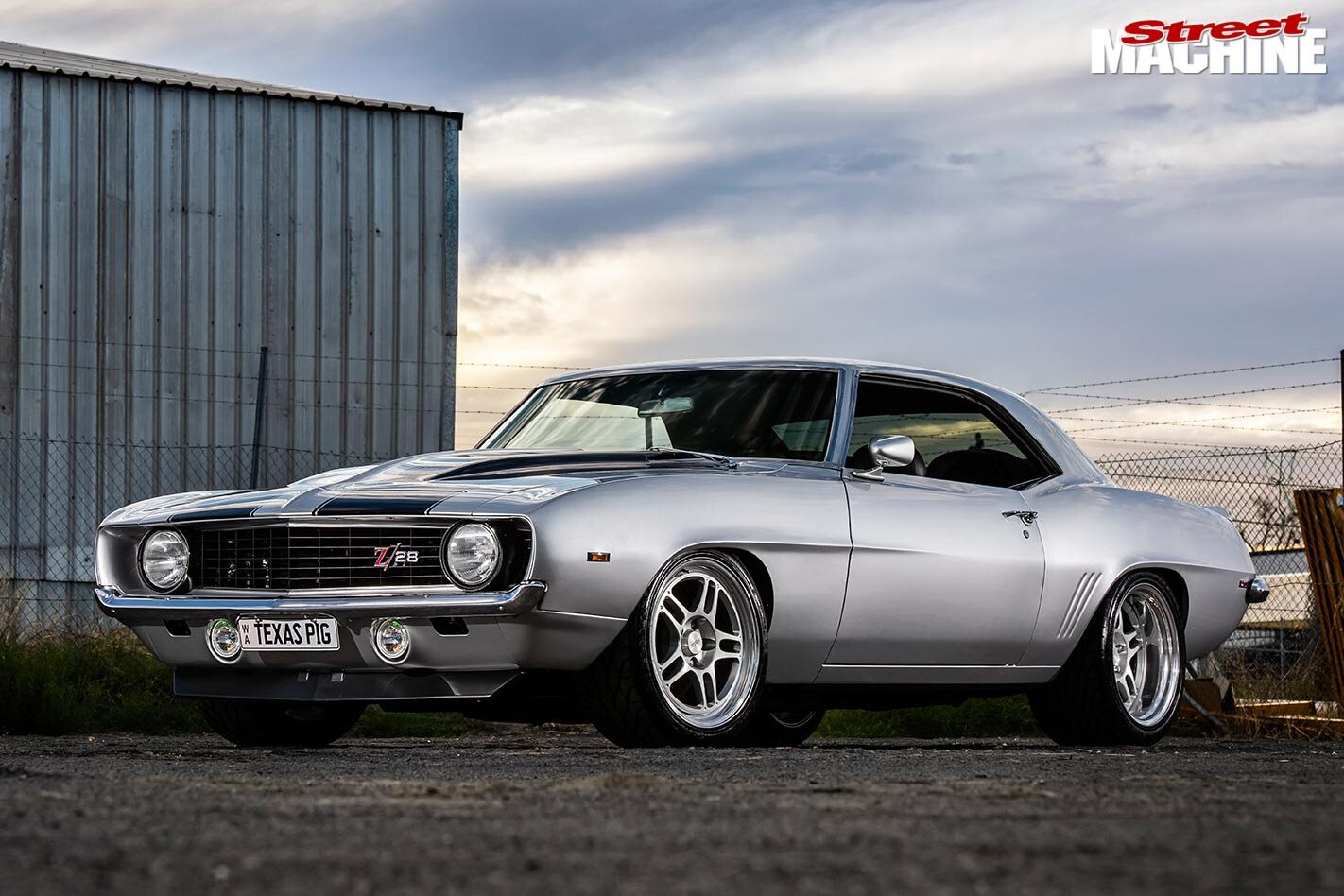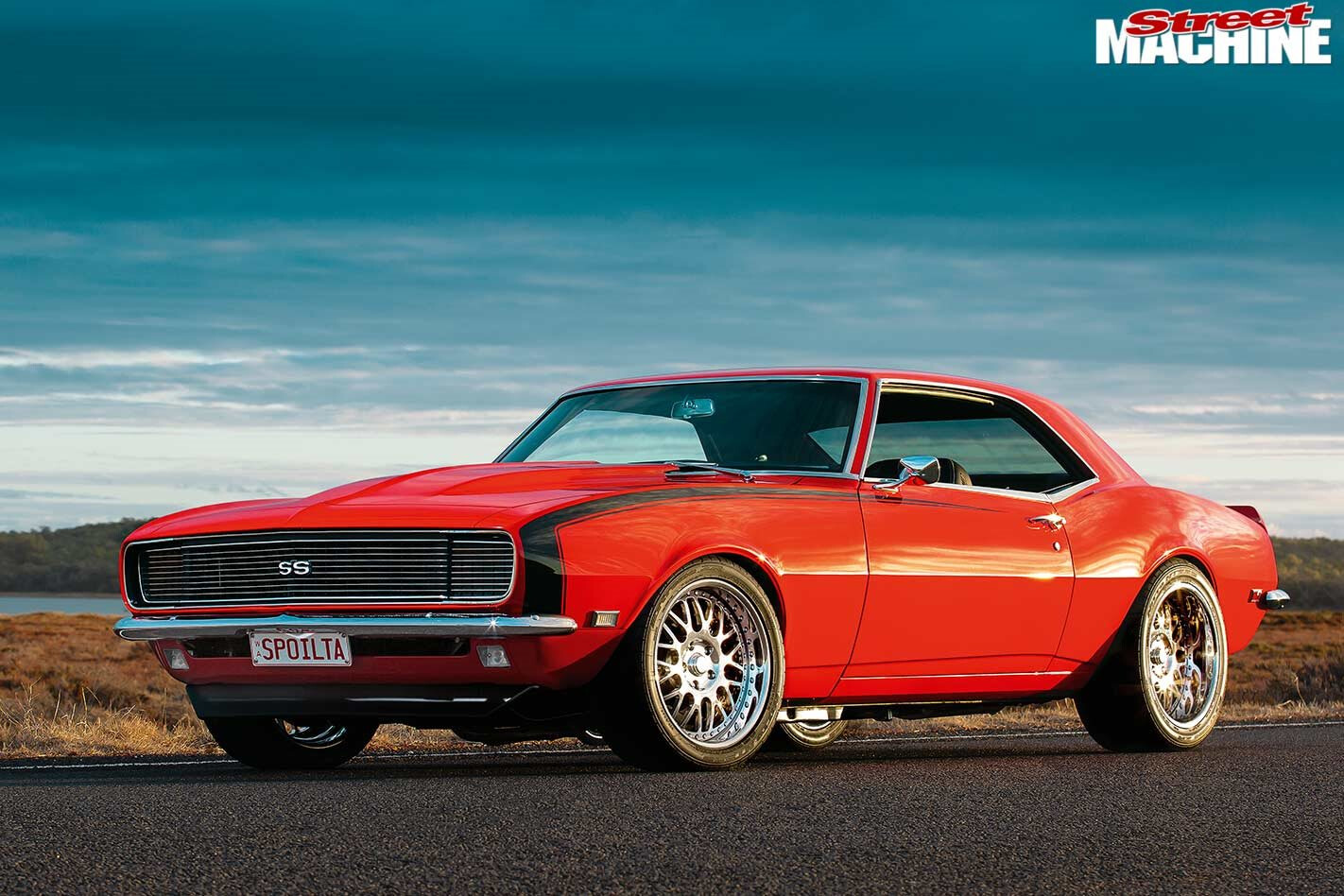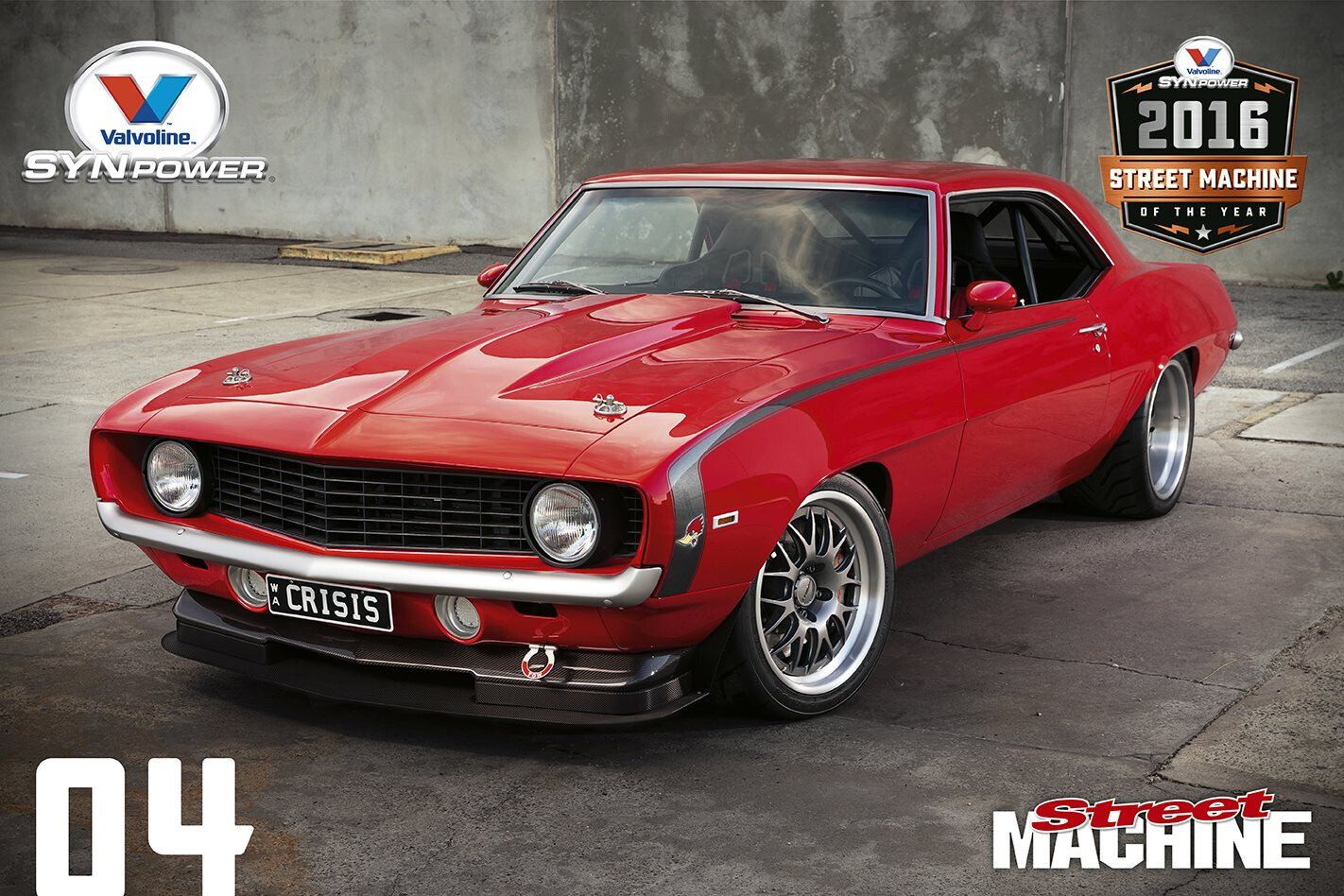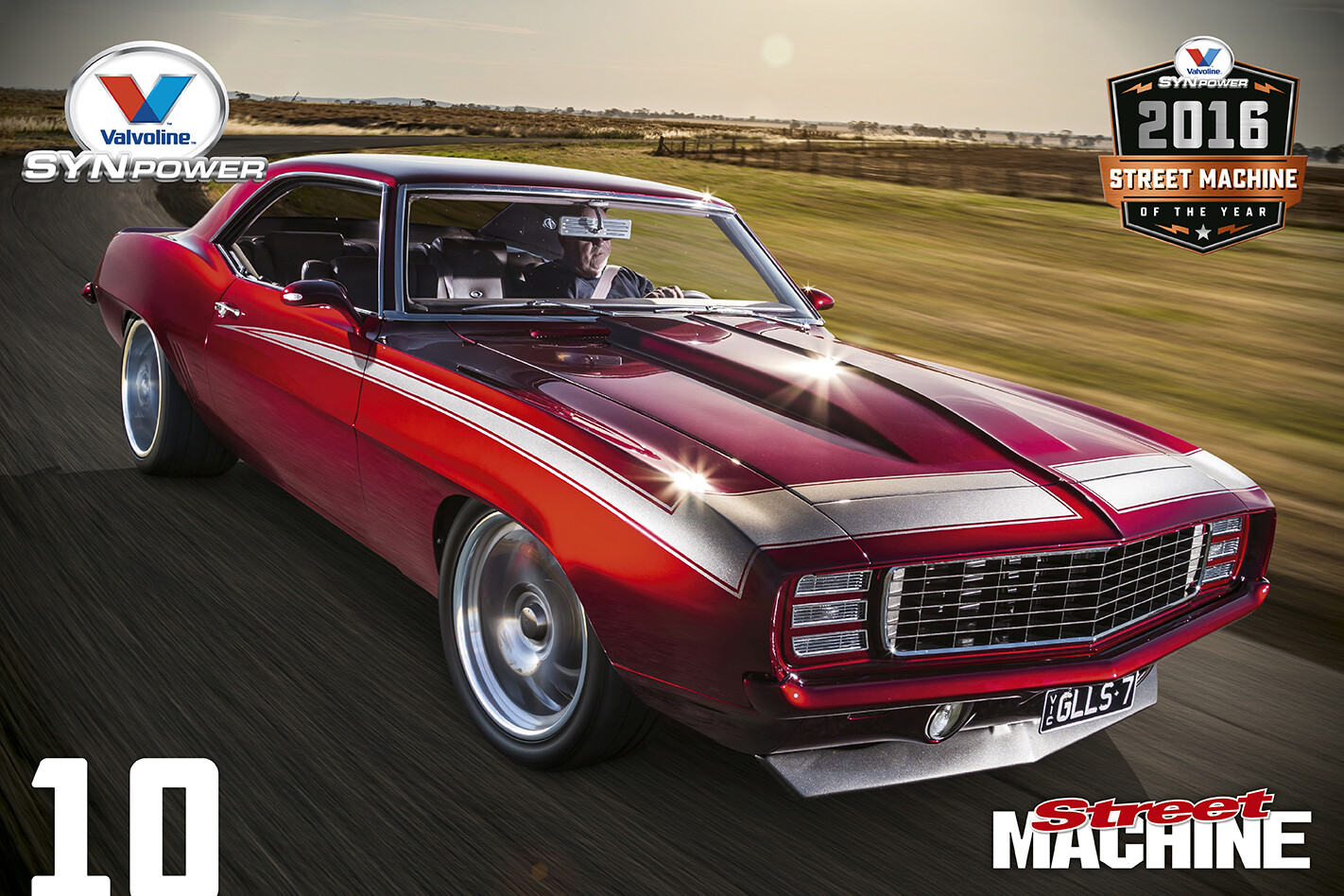THE number plate TEXAS PIG on Greg Freeman’s ’69 Camaro pretty much sums up the humble beginnings of this pro touring masterpiece – it was imported from Texas, and it was an absolute pig. “It was rooted. I blasted it and there was nothing left of it,” Greg confirms. “It had a 12-bolt in it and it looked reasonable, but it’s the first car I’ve ever bought without getting someone to go and look at it, and it came from a dealer. But as soon as I got it on the trailer I thought: ‘Oh my god.’ It was bolted together and that was about it.”
This article was first published in the September 2019 issue of Street Machine
A DSE mini-tub kit and a lot of tweaks to the wheelarches and inner fenders mean the 335 and 275 rubber have no clearance issues
It was a mess, but Greg was in a bit of a bind, as it was worth next to nothing as it sat, so he made the brave decision to rebuild the car properly. The first job was to remove all the rusty panels, which didn’t leave him with much: “The only things left were the sills and the roof; we even had to replace the bulkhead and firewall,” he says. This might sound like too daunting a task to most, but Greg’s no stranger to Camaros, with a ’68 Group Nc car and ’69 Targa car in the shed and many years’ experience as a motor body builder with his business, GT Fabrication.
The stance is spot-on thanks to a Heidts Pro-G front clip and a lowered leaf spring kit from DSE that was fine-tuned by Greg at the end of the build
The new sheet metal was expertly fitted by Rob Kite, who works with Greg and did the Camaro after hours. There was a fair bit of stuffing around to get the massive rubber to fit, with hours of work going into extending the inner wheelarches by 50mm so that the 275/40R18 tyres didn’t rub. Making sure the massive rubber stays planted is a Heidts Pro-G front end, which features coil-overs and massive 15-inch rotors and six-spot calipers from Wilwood.
Greg went to great lengths to make the massive big-block and Hilborn injection fit under the standard 2in reverse-cowl bonnet
I can still remember when a 275 was a massive rear tyre, but these days that just won’t cut it, especially in the pro touring scene, so Greg fitted a Detroit Speed Equipment (DSE) mini-tub kit to the rear to make plenty of room. As well as the bigger tubs, the kit moves the leaf springs inboard, allowing space for the 335/35R18 tyres. Mounted on Fikse three-piece rims measuring 10- and 12-inches wide, it’s the perfect wheel/tyre combo for the modern pro tourer.
The engine was built by TRE Race Engines in the US and was dynoed at over 800hp, but never ran right until Greg took it to Jeff at Streetbuilt Racing who sorted out the tune
But while the wheels turned out great, Greg took a bit of a punt on them. “I got the rims made in Canada and did all the backspacing with what I thought I needed, because I had the car half-assembled. I ordered the rims before I had the diff housing because I knew they were going to take a while; in the end it took nine months to get them. I bolted them on and they fit, so I didn’t have to throw them in the bin!” he laughs.
Greg’s goal was always to build a pro tourer; after all, he’s the kind of guy that likes to go around corners at pace. But he’s got his own interpretation of what makes a good pro tourer: “It should look original; no rollcage, no race seats or bonnet pins,” he says. One big benefit of a rollcage, apart from the added safety, is the stiffness it adds to a chassis, but Greg found another way around that. “We reinforced the floor so we didn’t have to run frame connectors,” he explains. “There’s box RHS through where the seat-base frame is, and it goes up around the tunnel, half in and half out, so you can only see a bit of it from underneath. I’ve made it strong and it’s fully seam-welded. I didn’t want to have big old rails hanging out there.”
The exhaust is a 3in MagnaFlow system that Greg modified to suit. The Stainless Works headers also needed to be tweaked to fit around the rack-and-pinion steering and make it easier to remove the plugs
With all of the suspension and chassis sorted, it was time get the drivetrain together, and Greg did not stuff around in that regard, sourcing a big-block Chev from TRE Racing Engines in the US. It’s based around a World Products Merlin III cast-iron block that’s filled with a Callies Magnum crank, Oliver rods and JE pistons. The Brodix BB-3 XTRA ally heads were CNC-ported and ensure there’s no restriction for the eight-stack Hilborn EFI. The Stainless Works headers have two-inch primaries that feed into a twin three-inch system from MagnaFlow that Greg tweaked to get it just right: “It’s just easier for me than buying mandrels and doing it that way; then I just get it ceramic-coated when it’s all done,” he says.
Greg is suitably impressed by the quality and performance of the Heidts Pro-G front end. The 15in Wilwood brakes with six-spot brakes also work a treat thanks to the Hydroboost system
All up it’s good for 820 dyno-proven horses, which means Greg needed a beefy drivetrain to send the power to. A Tremec TKO600 five-speed got the nod, while the old 12-bolt was turfed in favour of a Moser nine-inch with aluminium centre and Truetrac LSD. That should do the job nicely.
The interior is pretty straightforward, with a mix of old, new and aftermarket. There’s a DSE dash insert, Vintage Air air con and modified VY Monaro seats front and rear
The interior has been updated with a set of seats from a VY Monaro, including the rears, making the car a four-seater now. “I got rid of the electrics on the front seats, but with the back seats I needed to cut all the frames to shorten them, then reshape the foam,” Greg explains. “The filler panels I made from aluminium and had them covered in leather to match.” The instrument cluster was also updated, with a DSE insert filled with Auto Meter gauges and controls for the Vintage Air a/c.
The paint combination is a bit of a theme with Greg and his Camaros: “Both my other Camaros are black with silver stripes. I’ve never been a silver person, but when you see a ’69 in silver it just shows the lines up absolutely perfect,” he says. “I couldn’t just have it plain; I like the rallye stripes on them. I don’t know why they do it, but the boot stripes are further out than the front ones, so I made them the same right through.” The paint was applied by Aaron ‘Bunga’ Matthews, who first sprayed the inside and underneath the car in Raptor liner before applying the satin black in the engine bay and underneath. The PPG Switchblade Silver then went on before the stripes were masked and painted and the whole lot buried under three coats of clear.
The car turned out nice enough to score an invite to Meguiar’s Superstars at MotorEx 2018, and does everything asked of it: “Over 800hp, 700lb-ft of torque, runs on 91-octane and it stops and handles,” says Greg. Sounds like the perfect pro touring recipe.
GREG & SHIRLEY FREEMAN
1969 CHEVROLET CAMARO
Paint: PPG Switchblade Silver
ENGINE
Type: Big-block Chev
Inlet: Hilborn
Injection: Hilborn EFI
ECU: Holley HP
Heads: Brodix BB-3 XTRA
Valves: 2.30in (in), 1.89in (ex)
Cam: Comp Cams solid-roller
Pistons: JE
Crank: Callies Magnum
Conrods: Oliver
Radiator: Griffin radiator with Derale fan
Exhaust: Stainless Works headers, twin 3in stainless with MagnaFlow mufflers
Ignition: Holley dual-sync distributor, MSD 6AL-2
SHIFT
’Box: Tremec TKO600
Clutch: Centerforce dual-friction
Diff: Moser 9in, Truetrac, 31-spline
BENEATH
Front end: Heidts Pro-G subframe
Rear end: Detroit Speed Equipment leaf spring
Shocks: Heidts billet coil-over (f), Detroit Speed Equipment (r)
Steering: Power rack-and-pinion
Brakes: Wilwood 15in discs and six-spot calipers (f), Wilwood 14in discs and four-spot calipers (r)
ROLLING STOCK
Rims: Fikse; 18×10 (f), 18×12 (r)
Rubber: BFGoodrich g-Force T/A; 275/35ZR18 (f), 335/30ZR18 (r)
THANKS
I couldn’t have built the car without the help of my good friends Rob Kite (panel beater), Aaron ‘Bunga’ Matthews (painter), Peter May (mechanicals) and my wife Shirley




Comments